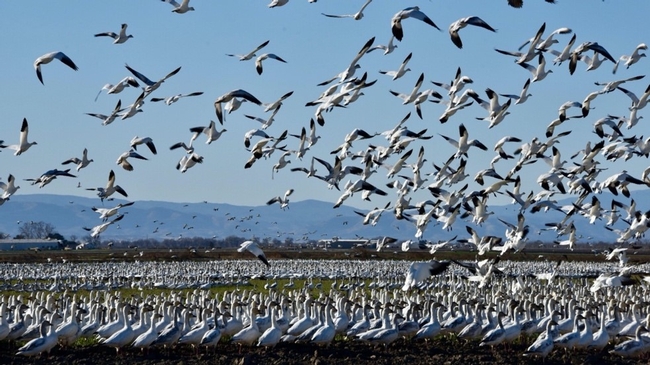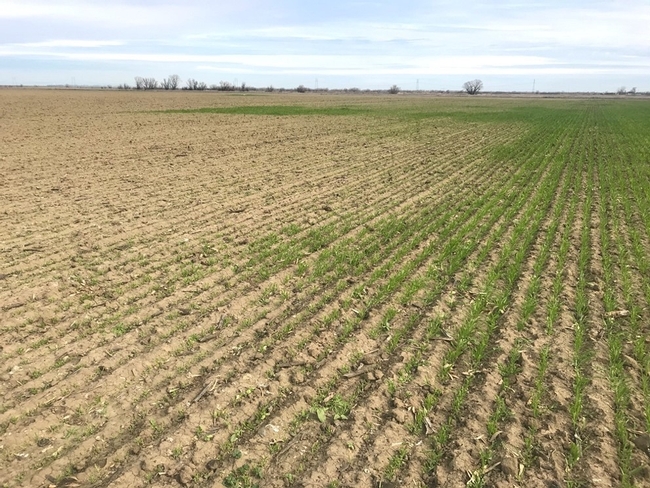Growers frequently celebrate the presence of wildlife in their alfalfa and grain fields, providing valuable habitat as well as economic returns.
But sometimes it's just too much of a good thing.
Snow geese and Ross's geese foraging in alfalfa hay in the Sacramento Valley, 2021. Photo: Steven Beckley, Woodland, CA
The sight of thousands of geese foraging in agricultural fields is spectacular and a natural wonder, until they start devastating your crop. This winter, snow and Ross's geese have been eating farmers out of house and home in the Sacramento valley, devastating wheat, cover crops, and alfalfa fields.
Millions of Guests Arriving for Dinner. Geese foraging by the tens of thousands are capable of consuming 30 acres of crops in just a few hours. They strip leaves and stems of alfalfa and pull up young wheat seedlings by the roots. Alfalfa hay fields will grow back, though farmers will generally lose their first cutting of alfalfa. Annual crops like winter wheat won't recover, leaving farmers to harvest whatever they can, resulting in substantial losses.
The Central Valley sits dead in the middle of the Pacific Flyway with millions of ducks and geese migrating from northern regions to the valley every year. A bird-watchers paradise, the Sacramento Valley supports one of the highest concentrations of waterfowl in the world with about 50% of all overwintering waterfowl in California found here, including 85% of all geese. As many as seven million ducks and geese or 10-15% of all North America's waterfowl call the Central Valley home during the winter months. This includes a third of all Pintails and almost the entire continental population of tule White-fronted geese and Aleutian Canada geese. Most geese overwinter in harvested rice fields, some in corn, particularly in the Delta, and the rest in wetlands. The rice, alfalfa, grains, and pasture cropping systems support this habitat.
Wheat Crop destroyed by thousands of grazing geese, Zamora, CA (R. Long, photo).
Why are geese such a problem this year? Snow and Ross's geese tend to be the most damaging to crops because they're most abundant. About 1.4 million arrive in our area every year. But this year they are particularly plentiful. Biologists point to a number of factors that created a perfect storm for wildlife conflicts with geese this year.
First, there was limited wetland habitat and food resources for geese in the Klamath Basin near the Oregon border and other stopping areas along migration routes due to drought. This resulted in several million hungry geese arriving in the Sacramento Valley a few weeks early, causing available food resources to be used up faster than usual.
Second, drought conditions here in the Central Valley resulted in fewer weeds and grasses germinating for geese to graze on. Third, the late winter rains resulted in late germinating wheat and cover crop fields, making them more susceptible to damage (due to their smaller growth stage) when geese started leaving refuges in search of more food.
How can one control geese? This is a big challenge since geese are protected by the federal Migratory Bird Treaty act and cannot be hunted out of season, which ended January 31, 2021. However, there's a late season goose hunt starting February 20-24. To keep geese out of fields outside of hunting season one can use scare tactics to try to keep them out. Some have tried scarecrows, sparkly streamers, electronic distress calls, and even the inflatable waving man. In good news, these devices seem to help keep smaller flocks of birds out of crop fields, preventing damage. The bad news is that geese are not fooled, as once they figure out there's no threat they will continue feeding.
Another way to try to control geese is by hazing and chasing them out of fields. Some have tried shotgun blasts, zon-guns, drones, dogs, and racing four wheelers across fields. But unfortunately, the satisfaction of seeing thousands of geese rise in the air with a deafening roar is short lived. When you're gone, they simply come back to finish eating, usually in response to your neighbors chasing them away from their fields. Once geese habituate to a field, it's hard to keep them off.
Will Lasers Help? Researchers Werner and Clark at Fort Collins, CO have tested motion-activated lasers in controlled studies and found that Canada Goose occupancy was reduced by 92% over a 20-day research period. However, these were studied in a captive small-field situation, and the authors suggest additional research to assess the spatial impact of this system for larger fields using doplar-type sensors. See Werner and Clark, 2010 publication. However, this looks like a promising control measure especially for smaller areas.
The USDA supports programs through Wildlife Services that can provide other options for producers to deal with wildlife depredation. Contact the USDA California Wildlife Service at 916-979-2675 for more information. However, one has to be ahead of the curve on this one because geese are fast and by the time permits are granted, the geese will likely have done their damage and moved on.
Future management of geese. On small organic farms, weeder geese are sometimes used to help control grass weeds. However, on a larger scale with tens of thousands feeding in a crop field, there's no hope for the crop. Unfortunately, with our western states getting warmer and drier with more drought conditions predicted in the future and a finite amount of food for geese, these wildlife conflicts will likely increase. This leaves a big need to figure out how to best manage geese in the future to ensure their protection, but to prevent crop losses.
Birds are beneficial! Overall, many birds are beneficial, as they feed on weeds, insects, and rodents, helping farmers by providing important pest control services. Birds can be commonly observed in alfalfa and grain fields, and mostly they are beneficial or do no harm. Approximately 28% of California's wildlife, most of them bird species uses alfalfa in some form (for nesting, feeding, or cover). See Alfalfa Wildlife and the Environment publication for a review of wildlife habitat, and a listing of species that use alfalfa.
It's good to be familiar with pest birds and when to implement practices to discourage them from feeding on crops to gain maximum benefits. For example, many flocking birds (e.g. blackbirds) feed on insect pests early in the season (needed for high energy sources for their baby birds) then switch to feeding on seeds later in the season. So, encouraging early season foraging by these birds is beneficial.
For more information on birds, we will be hosting a Virtual Field Day on beneficial and pest-consuming birds on March 31, 2021 at the Davis Ranch in Colusa County. To register, see the following website: https://www.wildfarmalliance.org/

